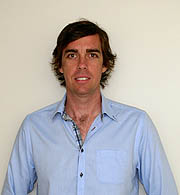Biological Science Faculty Member
Dr. Scott Burgess
- Office: 4021 King Life Sciences
- Office: (850) 645-9563
- Area: Ecology & Evolution
- Lab: King Life Sciences
- Lab: (850) 645-9564
- E-mail: sburgess@bio.fsu.edu

Associate Professor
Ph.D, University of Queensland, Australia, 2011
Graduate Faculty Status
Research and Professional Interests:
My research combines ecological and evolutionary principles to study the population biology of coastal marine invertebrates (such as corals, bryozoans, and gastropods). One main focus is on the evolution of dispersal, reproductive strategies, and life histories. Another main focus is on the ecology and evolution of cryptic species of corals in the genus Pocillopora. We typically use some combination of field and laboratory experiments, population, quantitative, and molecular genetics, and mathematical modeling/theory.
Please see the Lab home page for more info and publications.
Selected Publications:
See Google Scholar profile for complete and updated list
^ indicates a student, postdoc, or lab technician from the lab
2025
Burgess, S.C., Speare, K.E., McLachlan, R.H., Johnston^, E.C., Adam, T.C., Vega Thurber, R., Burkepile, D.E. (2025) Differential effects of nutrients and consumer pressure on sympatric cryptic coral species (Pocillopora spp.). Ecology 106: e70079 https://doi.org/10.1002/ecy.70079
Powell, J. A.^, & Burgess, S. C. (2025) Differential effects of temperature on multiple components of fitness in a modular animal reveal how temperature affects reproductive capacity. Functional Ecology 00, 1–12. https://doi.org/10.1111/1365-2435.70055
Barnes D.K^., Burgess, S.C. (2025) Fitness consequences of marine larval dispersal: the role of neighborhood density, arrangement, and genetic relatedness on survival, growth, reproduction, and paternity in a sessile invertebrate. Journal of Evolutionary Biology. voae125 https://doi.org/10.1093/jeb/voae125
2024
Burgess, S. C., Turner, A. M.^, & Johnston, E. C.^ (2024). Niche breadth and divergence in sympatric cryptic coral species ( Pocillopora spp.) across habitats within reefs and among algal symbionts. Evolutionary Applications, 17(8), e13762. https://doi.org/10.1111/eva.13762
Edmunds, P. J., Maritorena, S., & Burgess, S. C. (2024). Early post-settlement events, rather than settlement, drive recruitment and coral recovery at Moorea, French Polynesia. Oecologia, 204(3), 625–640. https://doi.org/10.1007/s00442-024-05517-y
Powell, J. A.^, & Burgess, S. C. (2024). How modularity and heterotrophy complicate the understanding of the causes of thermal performance curves: The case of feeding rate in a filter-feeding animal. Journal of Experimental Biology, 227(12), jeb247776. https://doi.org/10.1242/jeb.247776
Peniston, J. H.^, & Burgess, S. C. (2024). Larval and adult traits coevolve in response to asymmetric coastal currents to shape marine dispersal kernels. The American Naturalist, 203(2), E63–E77. https://doi.org/10.1086/728003
Edmunds, P. J., Combosch, D. J., Torrado, H., Sakai, K., Sinniger, F., & Burgess, S. C. (2024). Latitudinal variation in thermal performance of the common coral Pocillopora spp. Journal of Experimental Biology, 227(11), jeb247090. https://doi.org/10.1242/jeb.247090
Hooks, A.^, & Burgess, S.C. (2024). Variation in polyandry, reproductive output, and within-brood genetic diversity in a marine snail population across seasons and years. Marine Ecology Progress Series, 734, 65–77. https://doi.org/10.3354/meps14558
2023
Burgess, S. C., Powell, J.A^, & Bueno, M.^ (2023). Dispersal, kin aggregation, and the fitness consequences of not spreading sibling larvae. Ecology, 104(1). https://doi.org/10.1002/ecy.3858
Wyatt, A. S. J., Leichter, J. J., Washburn, L., Kui, L., Edmunds, P. J., & Burgess, S. C. (2023). Hidden heatwaves and severe coral bleaching linked to mesoscale eddies and thermocline dynamics. Nature Communications, 14(1), 25. https://doi.org/10.1038/s41467-022-35550-5
Johnston, E. C.^, & Burgess, S. C. (2023). Pocillopora tuahiniensis: A new species of scleractinian coral (Scleractinia, Pocilloporidae) from French Polynesia. Zootaxa, 5369(1), 117–124. https://doi.org/10.11646/zootaxa.5369.1.5
2022
Edmunds, P. J., Johnson, K. W., & Burgess, S. C. (2022). Branching coral morphology affects physiological performance in the absence of colony integration. Biology Letters, 18(12), 20220414. https://doi.org/10.1098/rsbl.2022.0414
Johnston, E. C.^, Cunning, R., & Burgess, S. C. (2022). Cophylogeny and specificity between cryptic coral species ( Pocillopora spp.) at Mo′orea and their symbionts (Symbiodiniaceae). Molecular Ecology, 31(20), 5368–5385. https://doi.org/10.1111/mec.16654
Burgess, S. C., Bode, M., Leis, J. M., & Mason, L. B. (2022). Individual variation in marine larval-fish swimming speed and the emergence of dispersal kernels. Oikos, 2022(3), e08896. https://doi.org/10.1111/oik.08896
Johnston, E. C.^, Wyatt, A. S. J., Leichter, J. J., & Burgess, S. C. (2022). Niche differences in co-occurring cryptic coral species (Pocillopora spp.). Coral Reefs, 41(3), 767–778. https://doi.org/10.1007/s00338-021-02107-9
2021
Hooks, A. P.^, & Burgess, S. C. (2021). Behavioral variability of hatchlings modifies dispersal potential in Crown Conch ( Melongena corona ): Why do larvae crawl away but sometimes swim? The Biological Bulletin, 241(1), 92–104. https://doi.org/10.1086/712873
Bitter, M. C., Wong, J. M., Dam, H. G., Donelan, S. C., Kenkel, C. D., Komoroske, L. M., Nickols, K. J., Rivest, E. B., Salinas, S., Burgess, S. C., & Lotterhos, K. E. (2021). Fluctuating selection and global change: A synthesis and review on disentangling the roles of climate amplitude, predictability and novelty. Proceedings of the Royal Society B: Biological Sciences, 288(1957), 20210727. https://doi.org/10.1098/rspb.2021.0727
Burgess, S. C., Johnston, E. C.^, Wyatt, A. S. J., Leichter, J. J., & Edmunds, P. J. (2021). Response diversity in corals: Hidden differences in bleaching mortality among cryptic Pocillopora species. Ecology, 102(6), e03324. https://doi.org/10.1002/ecy.3324
Burgess, S. C., & Bueno, M.^ (2021). When does growth rate influence fitness in a colonial marine invertebrate? Marine Biology, 168(1), 5. https://doi.org/10.1007/s00227-020-03804-9
2020
Edmunds, P. J., & Burgess, S. C. (2020). Emergent properties of branching morphologies modulate the sensitivity of coral calcification to high PCO2. Journal of Experimental Biology, 223(8), jeb217000. https://doi.org/10.1242/jeb.217000
Álvarez-Noriega, M., Burgess, S. C., Byers, J. E., Pringle, J. M., Wares, J. P., & Marshall, D. J. (2020). Global biogeography of marine dispersal potential. Nature Ecology & Evolution, 4(9), 1196–1203. https://doi.org/10.1038/s41559-020-1238-y
Olsen, K. C., Ryan, W. H., Winn, A. A., Kosman, E. T., Moscoso, J. A., Krueger-Hadfield, S. A., Burgess, S. C., Carlon, D. B., Grosberg, R. K., Kalisz, S., & Levitan, D. R. (2020). Inbreeding shapes the evolution of marine invertebrates. Evolution, 74(5), 871–882. https://doi.org/10.1111/evo.13951
Johnston, E. C.^, Counsell, C. W. W., Sale, T. L., Burgess, S. C., & Toonen, R. J. (2020). The legacy of stress: Coral bleaching impacts reproduction years later. Functional Ecology, 34(11), 2315–2325. https://doi.org/10.1111/1365-2435.13653

